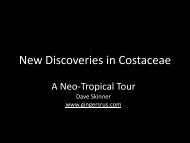BULLETIN - Heliconia Society International
BULLETIN - Heliconia Society International
BULLETIN - Heliconia Society International
Create successful ePaper yourself
Turn your PDF publications into a flip-book with our unique Google optimized e-Paper software.
PAGE 8 THE <strong>BULLETIN</strong> // JANUARY MAY 20092005<br />
Variations in <strong>Heliconia</strong> atropurpurea<br />
Carla Black, Apto. 00424-0027, Volcán, Chiriquí,<br />
Panamá<br />
carla@volcanbaru.com<br />
H. atropurpurea (typical form)<br />
On a recent trip to Costa Rica I found an unusual heliconia<br />
at the edge of the major highway connecting the capital San<br />
José with Guapiles on the Atlantic slope. The large population<br />
of plants is growing at approximately 1500 m elevation on steep<br />
embankments, mixed with H. clinophila.<br />
This plant is not recorded in the herbarium of the Instituto<br />
Nacional de Biodiversidad (INBio, www.inbio.ac.cr/es/<br />
default.html), which is preparing the flora of Costa Rica, nor is it<br />
known to Dr. John Kress or Dr. Gil Daniels, the two botanists<br />
most familiar with Costa Rican <strong>Heliconia</strong>. Upon seeing these<br />
photos, Dr. Kress identified it as a giant form of H. atropurpurea,<br />
adding that he has seen gigantism in other species as well.<br />
A similar heliconia grows at an orchid farm, Finca Dracula,<br />
close to my house in western Panama, where the farm manager<br />
says he carried it back from a forested area near Boquete,<br />
Panama. I haven’t seen this one in the wild yet. Photos of this<br />
plant appeared in the HSI Bulletin 14(1), January 2008, under<br />
the name H. sp. ‘Rojona’, a label I put on it principally for my<br />
own use.<br />
The known form of H. atropurpurea grows at about<br />
1000 m elevation in the same region as both of these large<br />
heliconias – middle elevations on the Atlantic slope in Panama<br />
and Costa Rica. All three are quite similar, though each shows<br />
individual characteristics.<br />
Overall size is the most striking difference between<br />
the two large forms and the described form. H. atropurpurea<br />
fruits hide inside deep bracts, while the new forms exert very<br />
large fruit above the lip of the bract. Flowers and staminodes<br />
show slight differences.<br />
The large plants have all-green leaves; this feature is<br />
shared with Panamanian H. atropurpurea, while the known<br />
Costa Rican plants are tinted purple under their leaves. The<br />
two large plants differ from each other in details of the bract<br />
shape, which can be seen in the photos.<br />
The large plants in Costa Rica were blooming a few<br />
months earlier than the known form.<br />
With Bruce Dunstan<br />
With author Carla Black<br />
H. atropurpurea (giant Costa Rican form)<br />
With Angel Rodriguez<br />
H. atropurpurea (giant Panamanian form, `Rojona')


